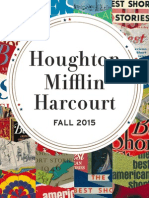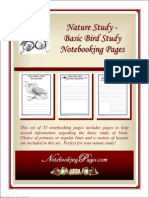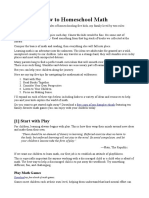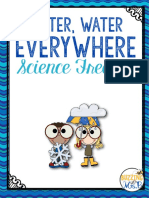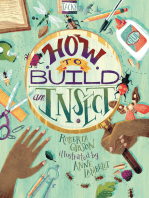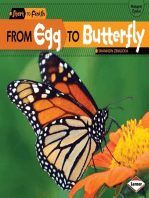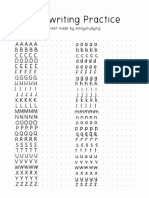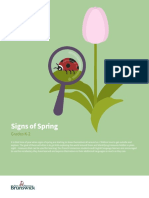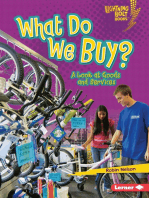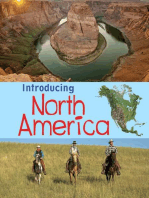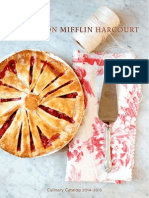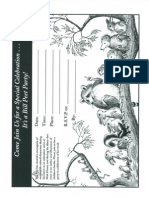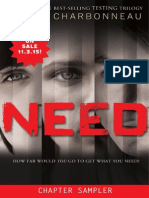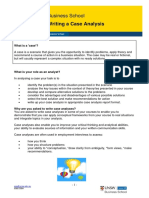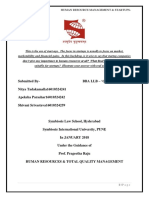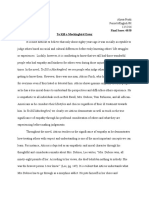Jenkins BeetleBook Guide
Jenkins BeetleBook Guide
Uploaded by
Houghton Mifflin HarcourtOriginal Description:
Copyright
Available Formats
Share this document
Did you find this document useful?
Is this content inappropriate?
Report this DocumentCopyright:
Available Formats
Jenkins BeetleBook Guide
Jenkins BeetleBook Guide
Uploaded by
Houghton Mifflin HarcourtCopyright:
Available Formats
A guide for discussion and classroom use
The Beetle Book
Steve Jenkins
Book Summary • Beetle larvae are a delicacy
The Beetle Book is another gem in some parts of the world.
in Steve Jenkins’s collection of Would you eat a beetle larva?
breathtakingly illustrated books Why or why not?
about the amazing quirks and • Beetles communicate with
curiosities of the natural world. one another and with other
Jenkins’s intricate and vivid animals in some interesting
cut-paper collages draw even ways. After reading The
non–bug lovers into the beetle Beetle Book, discuss the
world, and readers will also different methods of beetle
learn about how a quarter of communication you’ve
the earth’s living things spend their time! Jenkins tucks learned about. Can you think of other animals that
facts about beetles’ physiology, adaptations, and methods communicate in similar ways?
of communication and defense alongside pictures of beetles
that are so lifelike, they look like they just might scurry off Teaching Ideas
the page! • Study local beetles. Using books and Internet
resources, study with your class the beetles that
Discussion Questions for Reading Aloud are common to your area. Go on a beetle walk near
• How can you tell if a bug is a beetle as opposed to your school! Bring sketchbooks and pencils so that
some other kind of insect or a spider? students can sketch the beetles they see, and ask
• Think about the beetles you’ve seen near your students to share their findings as a class when you
home or school. After reading Jenkins’s book, how return. You may also have students photograph
many can you name? and write about the local beetles they’ve found.
• What are some features or behaviors of beetles that • Make a beetle wall. Collect students’ drawings,
make them unique in the insect kingdom? photos, and writing about beetles on a classroom
• Some beetles are considered pests, such as the “beetle wall,” to be added to as children discover
boll weevil—but some beetles do things that are new things about beetles. Invite other classes and
actually helpful to humans. Discuss how beetles children’s families to visit your beetle wall, and
can be humans’ helpers. have your students give guided tours!
• Beetles have evolved to have rigid outer wings
covering the soft inner wings that they use to fly.
How have these outer wings served beetles well?
Houghton Mifflin Books for Children • www.hmhbooks.com
• Is it a beetle? Collect either actual specimens or Introduction: Tell your students that because they have
pictures of various insects and spiders, enough for learned so much about beetles from reading The Beetle
teams of children to have a selection to examine. Book, by Steve Jenkins, they are ready to design their
Ask children to think of all that they know about own beetles! Tell them that they will be using what they
beetles’ characteristics as they sort the specimens know about beetles’ body parts and adaptations for
into two piles: beetles and not beetles. At the communication, defense, and/or camouflage to design
end of the sorting time, bring the class together beetles that could actually live on earth. Tell them that they
to share. Ask children to back up their sorting will be drawing and labeling diagrams of their beetles, and
decisions with facts they’ve learned about beetles’ then writing about them (you may want to save the writing
characteristics. for another session). If you have an example of a finished
• Using a variation on Jenkins’s cut-paper collage product, show your students. Tell your students that they
methods, have students make their own beetle may want to brainstorm the characteristics of their beetles
pictures using painted paper that they cut and and even do a sketch before working on the final diagram.
arrange. And don’t forget to ask them to give their beetles a name!
A Project: Design Your Own Beetle! *Especially if you are working with very young children,
(This project may take two or more sessions. It can be you may want to divide this work into several sessions—
adapted for use with primary or upper grade students) one for brainstorming and sketching, one for drawing the
diagram, one for adding color, and one or two for writing.
Materials needed: A copy of Steve Jenkins’s The Beetle Do what makes sense for your classroom.
Book, paper and art supplies of your choice, and writing
materials. You may want to create an example of an Work time: As your students work, circulate among them,
invented beetle diagram and written description, or if you offering help and suggestions as necessary.
have done this activity with students before, use a student
example. Share: Have your students share their beetles with a
partner, and then bring the class together to talk about
Background knowledge: It will be helpful if your students what they noticed when they were designing their own
have had several experiences with Steve Jenkins’s book beetles.
so that they are familiar with information about the parts
and adaptations of beetles. You may want to have recorded
some of this information in chart form so that children can
refer to it as they work.
Setup: Gather your students together in your class’s
meeting place. Have available a copy of The Beetle Book; A Guide for Discussion
examples of the paper and materials children will be using and Classroom Use
to design, draw, and write about their beetles; and your by Zoe Ryder White
sample beetle pictures and writing.
Houghton Mifflin Books for Children • www.hmhbooks.com
You might also like
- Stick and Stone Activity KitDocument8 pagesStick and Stone Activity KitHoughton Mifflin Harcourt100% (3)
- Mustache Baby Activity KitDocument10 pagesMustache Baby Activity KitHoughton Mifflin Harcourt0% (1)
- FrogDocument9 pagesFrogMaiyariNoch keine Bewertungen
- Healthy Living From The Start Curriculum Sample June 2021Document35 pagesHealthy Living From The Start Curriculum Sample June 2021Anesly Y. NewmanNoch keine Bewertungen
- Dragons at Crumbling Castle ExcerptDocument26 pagesDragons at Crumbling Castle ExcerptHoughton Mifflin Harcourt100% (1)
- Compost KidsDocument19 pagesCompost KidsJennifer Kupershlak0% (1)
- Sonlight BDocument1 pageSonlight BDebbie Engen-LarkinNoch keine Bewertungen
- Ire of Iron Claw Discussion GuideDocument26 pagesIre of Iron Claw Discussion GuideHoughton Mifflin HarcourtNoch keine Bewertungen
- How To Start A Fire by LIsa Lutz - Discussion QuestionsDocument1 pageHow To Start A Fire by LIsa Lutz - Discussion QuestionsHoughton Mifflin HarcourtNoch keine Bewertungen
- HMH Books For Young Readers Fall 15 CatalogDocument162 pagesHMH Books For Young Readers Fall 15 CatalogHoughton Mifflin HarcourtNoch keine Bewertungen
- HMH Fall 2015 General Interest CatalogDocument137 pagesHMH Fall 2015 General Interest CatalogHoughton Mifflin HarcourtNoch keine Bewertungen
- Ask The Dark by Henry Turner (Excerpt)Document24 pagesAsk The Dark by Henry Turner (Excerpt)Houghton Mifflin HarcourtNoch keine Bewertungen
- S6 BBA NegotiationDocument14 pagesS6 BBA NegotiationMireia Civit AdalidNoch keine Bewertungen
- Bluest Eye AnalysisDocument25 pagesBluest Eye AnalysisFernandez CyrusjhunylNoch keine Bewertungen
- Lara Freidenfelds - The Modern Period - Menstruation in Twentieth-Century America (2009) PDFDocument253 pagesLara Freidenfelds - The Modern Period - Menstruation in Twentieth-Century America (2009) PDFnitaNoch keine Bewertungen
- Wild World Handbook Creatures Educators' GuideDocument9 pagesWild World Handbook Creatures Educators' GuideQuirk BooksNoch keine Bewertungen
- All About Birds - Basic Bird Study Notebooking PagesDocument58 pagesAll About Birds - Basic Bird Study Notebooking Pageshannah.r-w7784100% (2)
- Denise GaskinsDocument46 pagesDenise GaskinsmmaticNoch keine Bewertungen
- Hands-On Bible Explorations: 52 Fun Activities for Christian LearningFrom EverandHands-On Bible Explorations: 52 Fun Activities for Christian LearningNoch keine Bewertungen
- Montessori Reading Program Info and LinksDocument11 pagesMontessori Reading Program Info and Linksapi-127589289Noch keine Bewertungen
- Solar System Grade 3 Unit Study: Contents of Kit To Be Returned To HCOSDocument10 pagesSolar System Grade 3 Unit Study: Contents of Kit To Be Returned To HCOSHCSLearningCommonsNoch keine Bewertungen
- Canada, My Country Unit Study Grades 2 & 3: 8/1/2013 RevisedDocument9 pagesCanada, My Country Unit Study Grades 2 & 3: 8/1/2013 RevisedHCSLearningCommonsNoch keine Bewertungen
- Potential & Kinetic EnergyDocument11 pagesPotential & Kinetic EnergyJay DanielNoch keine Bewertungen
- Daily Routine 2010Document2 pagesDaily Routine 2010ladyduskNoch keine Bewertungen
- The MittenDocument20 pagesThe Mittenapi-355514594Noch keine Bewertungen
- Monocot Dicot ColoringDocument3 pagesMonocot Dicot ColoringdebbyhooiNoch keine Bewertungen
- Interdisciplinary LessonsDocument9 pagesInterdisciplinary Lessonsapi-241792007Noch keine Bewertungen
- Water Cycle FreebieDocument8 pagesWater Cycle FreebieCosmin Ionut CristeaNoch keine Bewertungen
- Carroll M Promoting Diverse Literature Activity PlanDocument10 pagesCarroll M Promoting Diverse Literature Activity PlanMelissa CarrollNoch keine Bewertungen
- SeedsandplantsDocument12 pagesSeedsandplantsapi-296850134Noch keine Bewertungen
- Summer Fun Reading ActivitiesDocument35 pagesSummer Fun Reading Activitiesjanettagraham100% (2)
- Let's Investigate! Hands-On Science - Grades 1-2From EverandLet's Investigate! Hands-On Science - Grades 1-2Rating: 5 out of 5 stars5/5 (1)
- Discover Nature in Water & Wetlands: Things to Know and Things to DoFrom EverandDiscover Nature in Water & Wetlands: Things to Know and Things to DoNoch keine Bewertungen
- Slugs, Bugs, and Salamanders: Discovering Animals in Your GardenFrom EverandSlugs, Bugs, and Salamanders: Discovering Animals in Your GardenNoch keine Bewertungen
- Let's Make Easy Booklets!Document25 pagesLet's Make Easy Booklets!trespollitosNoch keine Bewertungen
- Japan Mini Book ADocument8 pagesJapan Mini Book AAngel WilliamsNoch keine Bewertungen
- Latin Living LiteratureDocument2 pagesLatin Living LiteratureHomeschool ConnectionsNoch keine Bewertungen
- Animal Groups (Mammals, Reptiles, Amphibians & More): Jumbo Science Book for Kids | Children's Zoology Books EditionFrom EverandAnimal Groups (Mammals, Reptiles, Amphibians & More): Jumbo Science Book for Kids | Children's Zoology Books EditionNoch keine Bewertungen
- Kaboom! What Happens When Volcanoes Erupt? Geology for Beginners | Children's Geology BooksFrom EverandKaboom! What Happens When Volcanoes Erupt? Geology for Beginners | Children's Geology BooksNoch keine Bewertungen
- Botony NotebookDocument23 pagesBotony NotebookparkeracadNoch keine Bewertungen
- Handwriting SheetDocument1 pageHandwriting SheetnosalkovaNoch keine Bewertungen
- SignsofspringDocument12 pagesSignsofspringapi-129044197Noch keine Bewertungen
- Famous World Leaders QuotesDocument12 pagesFamous World Leaders QuotesmickelleNoch keine Bewertungen
- Sir Cumference and The Sword in The Cone ActivitiesDocument2 pagesSir Cumference and The Sword in The Cone Activitiesapi-316123904Noch keine Bewertungen
- Spiders Lap BookDocument22 pagesSpiders Lap BookOLGA CARRASCO PINENT100% (1)
- Drum Dream Girl Discussion GuideDocument2 pagesDrum Dream Girl Discussion GuideHoughton Mifflin HarcourtNoch keine Bewertungen
- The Evening Chorus by Helen Humphreys - Discussion QuestionsDocument3 pagesThe Evening Chorus by Helen Humphreys - Discussion QuestionsHoughton Mifflin HarcourtNoch keine Bewertungen
- HMH Fall 2015 Young Readers CatalogDocument172 pagesHMH Fall 2015 Young Readers CatalogHoughton Mifflin HarcourtNoch keine Bewertungen
- Octopus Scientists Discussion and Activity GuideDocument7 pagesOctopus Scientists Discussion and Activity GuideHoughton Mifflin HarcourtNoch keine Bewertungen
- Eddie Red Undercover: Mystery in Mayan Mexico ExcerptDocument43 pagesEddie Red Undercover: Mystery in Mayan Mexico ExcerptHoughton Mifflin HarcourtNoch keine Bewertungen
- Undertow ExcerptDocument56 pagesUndertow ExcerptHoughton Mifflin HarcourtNoch keine Bewertungen
- HMH Spring 2015 Gift CatalogDocument148 pagesHMH Spring 2015 Gift CatalogHoughton Mifflin HarcourtNoch keine Bewertungen
- The Loch Ness Punster (Excerpt)Document30 pagesThe Loch Ness Punster (Excerpt)Houghton Mifflin Harcourt100% (2)
- Houghton Mifflin Harcourt 2014-2015 Culinary CatalogDocument112 pagesHoughton Mifflin Harcourt 2014-2015 Culinary CatalogHoughton Mifflin Harcourt67% (3)
- Tacky The Penguin Activity KitDocument14 pagesTacky The Penguin Activity KitHoughton Mifflin Harcourt100% (1)
- Savage Park by Amy Fusselman - Discussion QuestionsDocument1 pageSavage Park by Amy Fusselman - Discussion QuestionsHoughton Mifflin HarcourtNoch keine Bewertungen
- Curious George & Achieve Workbooks - BrochureDocument4 pagesCurious George & Achieve Workbooks - BrochureHoughton Mifflin HarcourtNoch keine Bewertungen
- Celebrate The 50 States Sell Sheet 2015Document2 pagesCelebrate The 50 States Sell Sheet 2015Houghton Mifflin HarcourtNoch keine Bewertungen
- Curious George & Achieve Workbooks - BrochureDocument4 pagesCurious George & Achieve Workbooks - BrochureHoughton Mifflin HarcourtNoch keine Bewertungen
- Black River by S. M. Hulse - Discussion QuestionsDocument2 pagesBlack River by S. M. Hulse - Discussion QuestionsHoughton Mifflin HarcourtNoch keine Bewertungen
- Bill Peet Activity KitDocument9 pagesBill Peet Activity KitHoughton Mifflin HarcourtNoch keine Bewertungen
- Steve Jenkins Discussion GuidesDocument10 pagesSteve Jenkins Discussion GuidesHoughton Mifflin HarcourtNoch keine Bewertungen
- Need Chapter SamplerDocument20 pagesNeed Chapter SamplerHoughton Mifflin Harcourt0% (1)
- Writing A Case Analysis: Business SchoolDocument4 pagesWriting A Case Analysis: Business SchoolBell SrisakhirunNoch keine Bewertungen
- Gall1980 PDFDocument7 pagesGall1980 PDFshridharNoch keine Bewertungen
- Daftar Rujukan MetakognisiDocument5 pagesDaftar Rujukan MetakognisimayaNoch keine Bewertungen
- English 11 Writing Assignment: The Crucible Act ReviewDocument2 pagesEnglish 11 Writing Assignment: The Crucible Act ReviewSharon GilbrethNoch keine Bewertungen
- DSST Rubric For Assessing Senior Project Presentations Student Presenter's Name: Panelist's NameDocument2 pagesDSST Rubric For Assessing Senior Project Presentations Student Presenter's Name: Panelist's NameJose Marie Carcueva AvilaNoch keine Bewertungen
- Detailed Lesson Plan in Arts Vi Oct 1Document3 pagesDetailed Lesson Plan in Arts Vi Oct 1maricel pampilo100% (1)
- Scrum Guide 2017 Vs 2020Document16 pagesScrum Guide 2017 Vs 2020Anonymous p7CY5EWh6Noch keine Bewertungen
- A Dialogical Approach To Conceptualizing Teacher IdentityDocument12 pagesA Dialogical Approach To Conceptualizing Teacher IdentityRamon CunhaNoch keine Bewertungen
- Terence McKenna - Non-Ordinary States Through Vision PlantsDocument3 pagesTerence McKenna - Non-Ordinary States Through Vision Plantsgalaxy5111Noch keine Bewertungen
- Captives of The Almighty (Sequel of The Captive's Diary) - Part 1 Episode 1 - 50Document369 pagesCaptives of The Almighty (Sequel of The Captive's Diary) - Part 1 Episode 1 - 50ayoolaayomide412Noch keine Bewertungen
- Tarbawi: Implementasi Pendidikan Karakter Melalui Kegiatan Pembelajaran Di Lingkungan SekolahDocument18 pagesTarbawi: Implementasi Pendidikan Karakter Melalui Kegiatan Pembelajaran Di Lingkungan SekolahwahyuNoch keine Bewertungen
- Reason and Revelation in The Middle Ages PDFDocument136 pagesReason and Revelation in The Middle Ages PDFManticora 1120100% (2)
- Notes On: Nothing Special: Living ZenDocument15 pagesNotes On: Nothing Special: Living ZenAnonymous qrSsYuxyoYNoch keine Bewertungen
- Reading SkillsDocument32 pagesReading Skillsekonurcahyanto94100% (6)
- Bipolar Course: Centre For Clinical InterventionsDocument2 pagesBipolar Course: Centre For Clinical InterventionsKareem FolajaiyeNoch keine Bewertungen
- Metacognitive Reading Strategies of Filipino College LearnersDocument18 pagesMetacognitive Reading Strategies of Filipino College LearnersMaan Gaerlan100% (1)
- Writing A Damn Good ScentanceDocument5 pagesWriting A Damn Good ScentanceDavid WolfswinkelNoch keine Bewertungen
- Fuelling The PassionDocument11 pagesFuelling The Passionfasi18Noch keine Bewertungen
- My MA ThesisDocument127 pagesMy MA ThesisAmal AlbureikanNoch keine Bewertungen
- Childhood SchizophreniaDocument14 pagesChildhood SchizophreniaAnalia WriterNoch keine Bewertungen
- Learning Styles ForumDocument2 pagesLearning Styles ForumLeonel Ariza BallenNoch keine Bewertungen
- SORC Model Example: Organism Situation Thoughts Feelings Reaction (Behavior/response) ConsequenceDocument25 pagesSORC Model Example: Organism Situation Thoughts Feelings Reaction (Behavior/response) ConsequenceEdster LesterNoch keine Bewertungen
- Case HistoryDocument32 pagesCase HistoryRashmi NNoch keine Bewertungen
- Carl Jung PPT EmmanuelDocument19 pagesCarl Jung PPT EmmanuelRuth Ignacias Jumao-asNoch keine Bewertungen
- Grade 8 PEriodical ExamDocument4 pagesGrade 8 PEriodical ExamDaniel FabianNoch keine Bewertungen
- HRM Project FinalDocument22 pagesHRM Project FinalShivani SrivastavaNoch keine Bewertungen
- TkambessayDocument4 pagesTkambessayapi-341273081Noch keine Bewertungen










